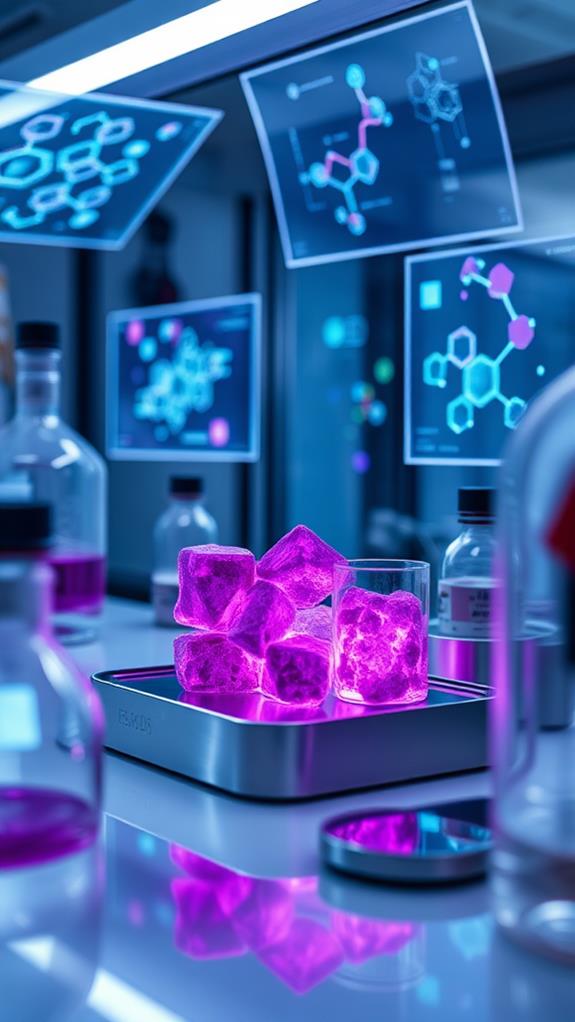Interesting Facts About Manganese You Never Knew
Manganese, an element you encounter daily, has a rich history and diverse applications you might not be aware of. Its use dates back 30,000 years to cave paintings, and it played a significant role in ancient glassmaking. In your body, manganese supports bone health and antioxidant function. Industrially, it's essential for steel production, enhancing strength and durability. Manganese is also necessary in battery technology, environmental purification, and wastewater treatment. Geopolitically, its limited reserves make it a key resource. As research continues, manganese's potential in sustainable energy and food security becomes increasingly apparent. Exploring this versatile element reveals a world of surprising connections and innovations.
This post may contain affiliate links. If you make a purchase through these links, I may earn a commission at no additional cost to you. Additionally, portions of this post may be generated using artificial intelligence (AI) technology. While we strive for accuracy, please be aware that AI-generated content may not always be perfect and should be fact-checked when necessary.
The Spatula Scoops
- Manganese use dates back 30,000 years, with early humans using it as a pigment in cave paintings.
- The human body contains 10-20 mg of manganese, essential for bone health and antioxidant function.
- 85-90% of consumed manganese is used in steelmaking, enhancing strength and toughness.
- Manganese plays a crucial role in battery technology, improving energy density and charging times.
- South Africa holds 74% of global manganese reserves, making it a geopolitically significant resource.
Ancient Uses of Manganese

While you might think of manganese as a modern industrial material, it's been part of human history for millennia. This versatile element has played a significant role in ancient civilizations, with evidence of its use dating back 30,000 years. You'd be surprised to learn that manganese was a key component in early cave paintings found in France, where it served as a natural pigment.
The ancient Egyptians were ahead of their time, using manganese dioxide to enhance their glassmaking process as far back as 2000 BC. They discovered its ability to decolorize glass, improving its clarity and quality. Even Neanderthals left behind blocks of pyrolusite, suggesting they used it for artistic or cosmetic purposes.
The Spartans unknowingly benefited from manganese in their iron ore, which resulted in superior steel weapons with improved strength and durability. This early industrial application gave them a significant advantage in warfare. Pliny the Elder, a Roman author, documented manganese compounds' use in glassmaking during the 1st century AD, highlighting its importance in ancient industrial processes. These early applications set the stage for manganese's continued relevance in modern industries.
Manganese in Human Biology

You'll find manganese playing a vital role in your body as an essential cofactor for numerous enzymes. It's particularly important for maintaining healthy bones, as it supports the formation and metabolism of connective tissues. Your body relies on manganese for proper skeletal development and bone density, making it a key player in overall bone health throughout your life.
Essential Enzyme Cofactor
Manganese serves as an fundamental cofactor for numerous enzymes in the human body, playing an important role in various biological processes. As an necessary trace element, manganese is imperative for your metabolism and antioxidant function. You'll find that it's particularly critical for the enzyme superoxide dismutase, which protects your cells from oxidative stress by converting harmful superoxide radicals into less damaging substances.
Your body contains about 10-20 mg of manganese, and you need to consume 2 to 5 mg daily to meet your dietary requirements. This mineral isn't just important for enzyme function; it's also essential for maintaining your skeletal health. Manganese aids in the synthesis of connective tissue and bone formation, ensuring the integrity of your skeletal system.
If you're not getting enough manganese, you may experience health issues related to its deficiency. These can include impaired bone formation, reproductive problems, and disturbances in glucose metabolism. To avoid these complications, it's crucial to maintain adequate manganese levels through a balanced diet or, if necessary, supplementation under medical supervision.
Bone Health Support
Contributing considerably to skeletal health, manganese plays an essential role in maintaining strong bones and connective tissue. This often-overlooked nutrient is a vital cofactor for enzymes involved in bone development, helping synthesize cartilage and bone matrix. You might not realize it, but manganese is working hard to keep your bones healthy and strong.
When you're not getting enough manganese, your body can't function effectively. A deficiency can lead to skeletal abnormalities and impaired bone growth, highlighting just how important this mineral is for your overall bone health. To keep your bones in top shape, you need about 2.3 mg of manganese daily. This adequate intake supports your bone metabolism and can help reduce your risk of osteoporosis as you age.
But that's not all manganese does for your bones. It's also a key component of the antioxidant enzyme superoxide dismutase. This enzyme protects your bone cells from oxidative stress, which can damage them over time. By incorporating manganese-rich foods into your diet, you're giving your bones the support they need to stay strong and healthy throughout your life.
Industrial Applications and Importance

Manganese's industrial applications are far-reaching and essential, with its most significant impact seen in steel production. You'll find this versatile element enhancing the strength and durability of steel, while also playing a key role in advancing battery technology, particularly in alkaline batteries. Beyond these primary uses, manganese contributes to environmental purification efforts, showcasing its importance across various industrial sectors.
Steel Production Enhancement
In the domain of steel production, you'll find manganese playing a pivotal role. This essential alloying element enhances steel's strength, toughness, and hardenability. You might be surprised to learn that 85-90% of globally consumed manganese goes into steel production. When you add just 1% manganese during steelmaking, you'll notably improve the steel's resistance to wear and impacts, making it ideal for construction and heavy machinery.
The Bessemer process revolutionized steel production by incorporating manganese to remove excess oxygen and sulfur, enhancing steel quality and durability. You'll also encounter ferromanganese, an alloy containing 74% manganese, which serves as a vital deoxidizing agent in steel refinement. If you're looking for extreme strength, manganese steel, with its 13% manganese content, is your go-to material for high-impact applications like railway tracks and construction equipment.
Battery Technology Advancements
Beyond its role in steel production, manganese has become a powerhouse in battery technology. You'll find this versatile element playing a vital part in alkaline batteries, where it enhances energy density and efficiency. But that's not all – manganese is making waves in lithium-ion batteries too.
Lithium manganese oxide (LMO) is increasingly used in battery technology due to its stability and safety advantages over cobalt-based alternatives. This shift is driven by manganese's cost-effectiveness and abundance, making it an attractive option for large-scale energy storage solutions. You'll see its impact in electric vehicles and renewable energy systems.
Manganese's electrochemical performance is impressive. It provides a high capacity for lithium storage, resulting in faster charging times and longer battery life. These advancements are essential for the growing demand in sustainable energy solutions.
As research continues, you can expect to see ongoing improvements in manganese battery technology. Scientists are working on enhancing recycling processes and minimizing environmental impacts. This focus on sustainability aligns with the global push for greener energy alternatives. With manganese at the forefront, you're witnessing a revolution in battery technology that's shaping our energy future.
Environmental Purification Applications
Environmental cleanup efforts have found a powerful ally in manganese. You'll find this versatile element playing a vital role in various purification processes. As a catalyst in wastewater treatment, manganese helps break down organic pollutants, greatly improving water quality. Its compounds, particularly manganese dioxide, are adept at removing heavy metals from contaminated water, making it an invaluable tool in environmental cleanup operations.
In industrial applications, manganese ore is essential for producing ferroalloys, which are used to reduce the environmental impact of smelting processes. Steel manufacturing also benefits from manganese's ability to reduce sulfur and oxygen impurities, leading to lower emissions during production.
Researchers are exploring sustainable sources of manganese, such as mining manganese nodules from the ocean floor. This approach aims to minimize environmental disruption caused by traditional extraction methods.
Here's how manganese contributes to environmental purification:
- Filters out harmful contaminants from water
- Catalyzes the breakdown of pollutants in wastewater
- Removes toxic heavy metals from industrial effluents
- Reduces emissions in steel production processes
Environmental Impact and Sustainability

Manganese's dual nature as an environmental boon and potential hazard highlights the complexity of its sustainability profile. You'll find that manganese mining processes can lead to environmental degradation, affecting local habitats and ecosystems. However, it's not all doom and gloom. Responsible sourcing of manganese contributes to cleaner steel production, improving air quality and reducing greenhouse gas emissions.
When you look at the ecological impacts of manganese extraction, you'll see the importance of implementing sustainable practices. Mining companies are now focusing on minimizing soil and water pollution through strict regulations. They're also working on restoration efforts post-extraction to protect biodiversity.
You might be surprised to learn that manganese plays a vital role in photosynthesis, influencing Earth's oxygen levels. This underscores the need for balanced approaches to manganese extraction and use. Ongoing research aims to find innovative ways to meet industrial needs while conserving the environment.
As you consider the environmental impact of manganese, remember that it's a complex issue. The goal is to harness its benefits while mitigating its potential negative effects on our planet.
Geopolitical Considerations of Manganese

While environmental concerns shape manganese's sustainability profile, its geopolitical implications are equally significant. You might not realize it, but manganese's supply chain is fraught with potential risks. The global supply risk index for this essential mineral stands at 5.7, indicating substantial vulnerabilities. South Africa holds a staggering 74% of the world's identified manganese resources, which, combined with its political stability score of 44.3, raises concerns about potential supply disruptions.
As a reader, you should be aware that the U.S. relies entirely on imports for manganese materials. This dependence has prompted worries about supply chain security, especially given increasing geopolitical tensions. The Department of Defense's designation of manganese as a Critical Mineral Resource underscores its strategic importance to U.S. industries, particularly in steel production and defense applications.
Consider these geopolitical factors:
- Concentration of reserves in a few countries
- Political instability in major producing regions
- U.S. dependence on foreign imports
- Strategic importance for national defense
Understanding these geopolitical considerations is vital for grasping the complexities surrounding manganese's global supply and its impact on various industries.
How Does Iodine Compare to Manganese in Terms of Benefits and Usage?
Iodine and manganese serve crucial roles in the body, though their functions differ. While manganese supports bone health and metabolism, iodine is vital for thyroid function and hormonal balance. Interesting iodine facts reveal its significance in preventing goiter and supporting cognitive development, showcasing its unique benefits compared to manganese.
Future Research and Innovations

As we look to the future, manganese research and innovation are poised to revolutionize multiple industries. You'll find scientists focusing on developing sustainable extraction methods, particularly from oceanic nodules. This could greatly reduce the environmental impact of manganese mining, a key concern in today's eco-conscious world.
In the sector of energy, manganese is making waves in battery technology. Researchers are exploring manganese-based compounds to enhance energy density and battery life, especially for electric vehicles. You might soon see these advancements powering your car or smartphone.
Health researchers are delving into the neurotoxic effects of manganese exposure, studying its impact on cognitive functions. This is particularly important for populations with high industrial exposure. Meanwhile, in the field of chemical engineering, manganese's role as a catalyst is being investigated to improve efficiencies in biofuel production and chemical synthesis.
Agricultural science isn't left behind. Scientists are examining manganese's role in crop development, aiming to create fortified fertilizers. These could boost plant growth and improve yields in manganese-deficient soils, potentially addressing food security challenges worldwide.
Frequently Asked Questions
What Are 5 Interesting Facts About Manganese?
You might be surprised to learn that manganese has been part of human history for over 30,000 years, used in cave paintings. It's essential for steel production, making up 85-90% of U.S. demand in that industry. Manganese's multiple oxidation states allow it to participate in various chemical reactions. Your body contains about 12 mg of this element, vital for enzyme function. It's the twelfth most abundant element in Earth's crust, found in minerals like pyrolusite and rhodochrosite.
What Are Unique Properties of Manganese?
You'll find manganese has several unique properties. It's one of the few elements that can exist in multiple oxidation states, each with its own distinct color. You'll notice it's hard yet brittle, and it readily oxidizes when heated. Manganese's ability to form diverse compounds makes it valuable in various applications. You'll see it used as a decolorizer in glassmaking and as a pigment in paints. Its biological importance is also significant, playing essential roles in enzyme function and metabolism.
What Are the Interesting Facts About Manganese in Plants?
Like a hidden conductor in nature's orchestra, manganese plays a vital role in plant life. You'll find it essential for photosynthesis, where it helps split water molecules to produce oxygen. It's also a key player in enzyme activation, supporting various metabolic processes. You might be surprised to learn that manganese deficiency can cause interveinal chlorosis, making leaves look like they're sporting a peculiar pattern. In fertilizers, it's your ally for boosting plant growth and disease resistance.
Why Is Manganese Special?
Manganese is special because you'll find it's essential for both living organisms and industrial processes. In your body, it's vital for enzyme function, metabolism, and antioxidant defense. You need it for bone formation and proper nutrient absorption. In industry, you'll see manganese used to strengthen steel, making it more resistant to wear and fracture. Its versatility is remarkable, with applications ranging from ancient cave paintings to modern glassmaking. You'll appreciate manganese's multiple oxidation states, which contribute to its diverse uses.





